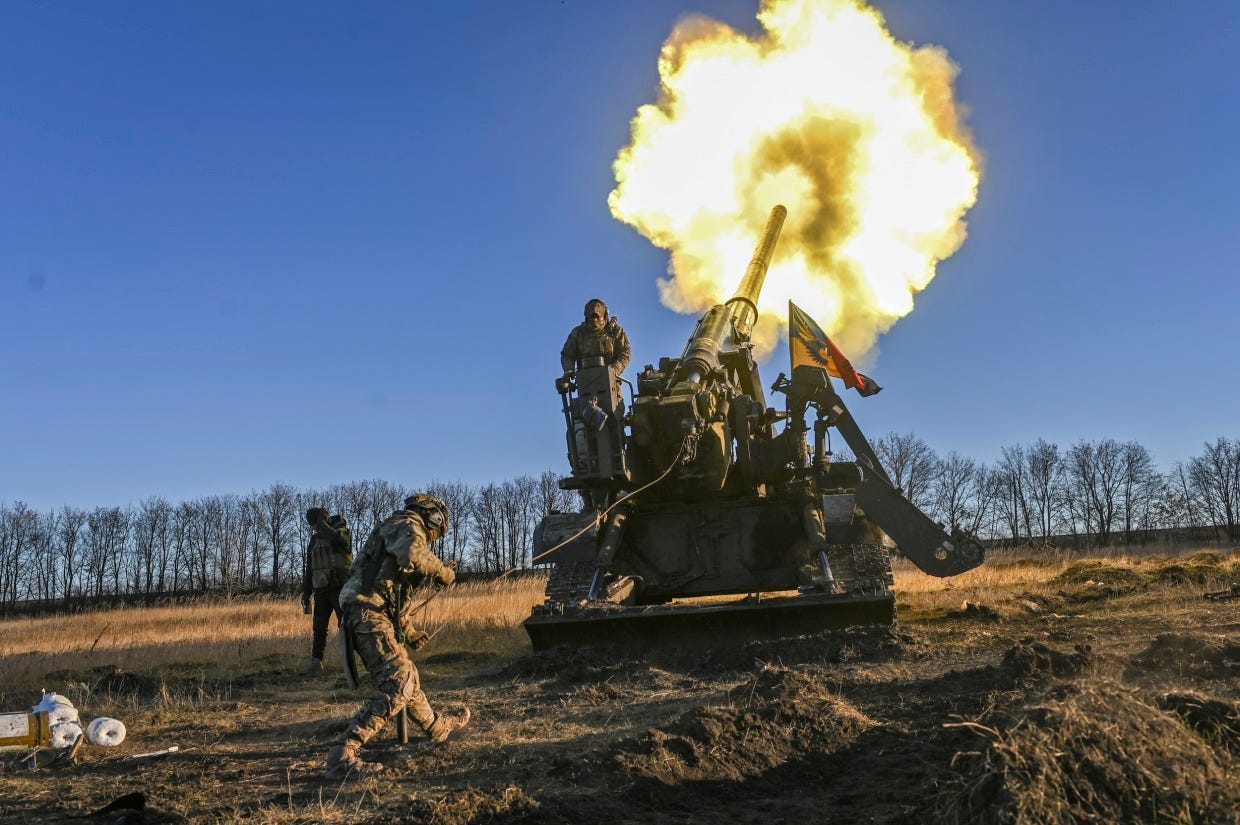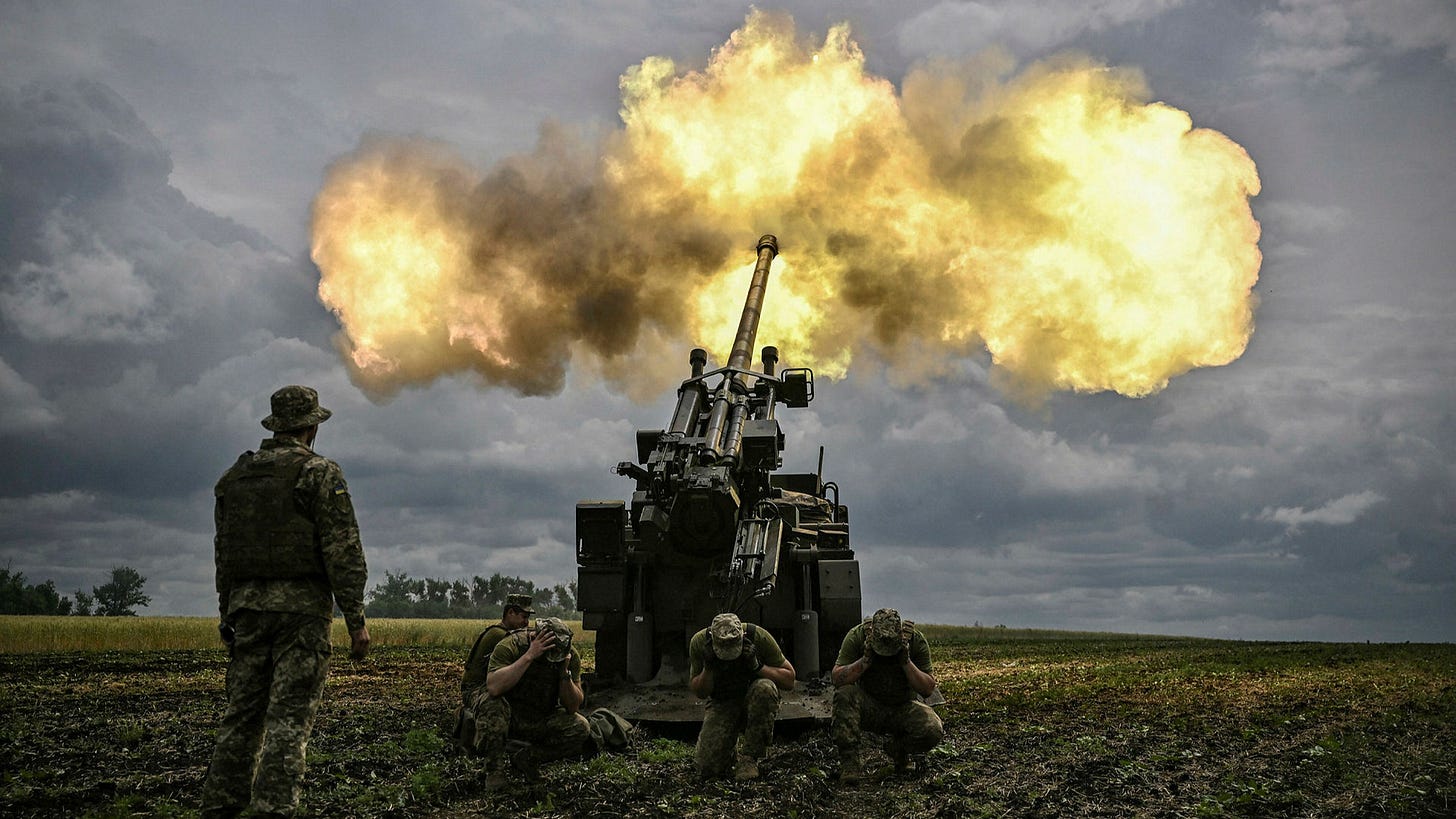A couple of weeks ago, Ukraine’s Defence Minister Oleksiy Reznikov wrote a letter to his 27 EU counterparts asking for 250,000 artillery shells per month, saying the Ukrainian army is currently firing less than a fifth of the shells it is capable of firing.
Reznikov writes that artillery plays a “crucial role in eliminating the enemy’s military power”. On average Ukraine was firing 110,000 155mm-calibre shells a month, he says — a quarter of the amount used by Russia. “If we were not limited by the amount of available artillery shells, we could use the full ammunition set, which is 594,000 shells per month,” he said, referring to the capacity of the artillery systems available to Ukraine. “According to our estimates, for the successful execution of battlefield tasks, the minimum need is at least 60 per cent of the full ammunition set, or 356,400 shells per month.” 1
Is 250,000 artillery shells per month a lot? Oh yeah. According to a Business Insider report, in January of 2023, the US military-industrial complex - the world’s largest and wealthiest - manufactured only 14,000 artillery shells monthly. The plan was to increase the production to 20,000 per month by the Spring of 2023 and to 90,000 monthly by 2025.2 The situation with artillery ammunition production in Europe is even worse, according to EU diplomats interviewed by FT (and notice how he did not say “makes,” but “can make”):
“Every day, Russia is shooting as many shells as Europe can make in a month.”
If you think the hundreds of thousands of shells Ukraine’s Defense Minister says his army needs every month is a huge number, I have more news for you: he only refers to the 155-mm howitzer shells. This is the most common NATO-standard caliber, but Ukraine is not NATO, and its army operates a veritable zoo of artillery systems, including 105-mm, 122-mm, and 152-mm calibers.

Per the Department of State, the U.S. has already dispatched the following ordnance to Ukraine:
In excess of 1,000,000 conventional 155-mm NATO-compliant projectiles;
Over 6,000 precision-guided munitions (PGMs) of 155-mm caliber;
400,000 rounds of 105-mm caliber;
45,000 units of 152-mm Soviet-era caliber;
20,000 rounds of 122-mm Soviet-era caliber.
The initial trio aligns with NATO specifications, while the latter two are compatible with legacy Soviet artillery systems. This poses a logistical challenge, as Ukraine's armed forces maintain a substantial arsenal of Soviet-era equipment, including approximately 750 152-mm caliber guns and 350 122-mm caliber artillery pieces. According to the NYT, the AFU had approximately 350 Western-made howitzers by late fall 2022. Most of them were M777 155-mm and M119 105-mm.3

Ukraine’s need for ammunition does not stop with artillery, of course. There are also tanks. And, once again, the variety is bewildering. The AFU expects to receive a total of approximately 700 tanks from Europe and the US. A significant portion of this equipment has already been delivered, including more than three hundred and fifty T-72s, Polish PT-91s, and nearly thirty Slovenian M-55s. The numbers of the more modern NATO tanks are modest in comparison:
14 Challenger 2s from the UK;
14 Leopard 2A4s from Poland;
100+ Leopard 1A5s from Germany, Denmark, and the Netherlands;
8 Leopard 2A4s from Canada and the same number from Norway;
6 Leopard 2A4s from Spain;
18 Leopard 2A6s from Germany and three from Portugal;
10 Strv 122s (upgraded Leopard 2A5s) from Sweden;
31 M1 Abrams from the US;
Just how Ukraine is going to service this motley crew is a riddle wrapped in a mystery inside an enigma, to quote Churchill. But, here I am talking only about the ammo; many of these tanks have different requirements. Leopard 1, for example, has a 105-mm main gun, while Leopard 2 - has a 120-mm. Challenger 2, Abrams, and Leopard 2 all have a 120-mm gun but cannot share ammunition due to various peculiarities of their design.

If Ukraine had years of peace and quiet to figure this out, it would. But it only has weeks, and the circumstances are far from peaceful. To complicate issues, much of this promised equipment is still very far from Ukraine and needs to be serviced before it can be shipped. Many of these tanks and other combat vehicles have been pulled from deep storage, where they awaited disposal. In some cases, the reason why these vehicles survived as long as they did was the cost of getting rid of them: storing them was cheaper than cutting them down in an environmentally friendly manner.
The feeling in Kiev is that the AFU must show results in the next two months. If it fails to deliver, NATO support is likely to dry up. Currently, Ukraine suffers over five hundred casualties daily in Bakhmut alone. For weeks, the US has been dropping hints that the AFU must abandon the town and concentrate on its planned “Spring offensive.” But Zelensky wouldn’t let Bakhmut go. In fact, he doubled down on its defense by throwing some of the AFU’s best units into the meat grinder.
Is he high, insane, or just pigheaded? Probably all of those, but he also has good reasons. For over a year now, Ukraine’s been surviving without social services, electricity, and other basic utilities, without jobs and the economy in general. The threat to Zelensky’s regime is not exclusively external. Zelensky used Bakhmut as a symbol of resistance - “Fortress Bakhmut,” in his own words - for his fundraising trip to Washington in December. Losing a symbol will have far-reaching consequences not just abroad but especially at home.
Foy, Henry and Andy Bounds. "Ukraine asks EU for 250,000 artillery shells a month." Financial Times, 3 Mar. 2023, www.ft.com/content/75ee9701-aa93-4c5d-a1bc-7a51422280fd.
Davis, Charles R. "Pentagon increasing production of 155mm artillery shells by 500%." Business Insider, 25 Jan. 2023, www.businessinsider.com/pentagon-increasing-production-of-155mm-artillery-shells-2023-1#:~:text=The%20US%20currently%20makes%20just%20over%2014%2C000%20rounds%20per%20month.
Ismay, John and Thomas Gibbons-Neff. "Artillery Is Breaking in Ukraine. It’s Becoming a Problem for the Pentagon." N.Y. Times, 25 Nov. 2022, www.nytimes.com/2022/11/25/us/ukraine-artillery-breakdown.html.





